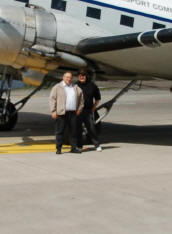
How It All Started
It was the morning of Monday 7th May 1962.
A few early risers were wandering about the the charred gorse and smashed metal, trying to take in the sudden destruction that had so recently come to this peaceful place. The fenced hillside was now open with gaping holes in the wire netting that until yesterday had secured the perimeter of the RAF compound. The tyre marks of rescue vehicles, fire engines and emergency vehicles were clearly visible on the ground. Sightseers cars were parked along the track way outside and people were scrambling over the low bank that served as a boundary between the road and the radar site. A small boy quietly opened the back door of his parent's Morris Minor, climbed out and swiftly crossed the track, heading for the fence. After clambering up the bank and through the hole in the wire he set off to follow Dad, wherever he might be going.
Suddenly the gorse bushes, which had formed a near impenetrable barrier to a five
year old, opened into a vista of open hillside -
Only an hour before my Father had looked up from his paper and announced that an aircraft had come down nearby and that after our holiday hotel had served breakfast, he wanted to go and have a look. Dutifully Mother went with him and as a child, I had to go to. Very soon I had seen things never to be forgotten.
Many years later I decided to discover what really happened. There followed a year
of findings, revelations and 'happenings' -
After this unexpected meeting, we began work on the second part of the project and the idea of a memorial website was discussed. Having written the text and loaded it onto the server, I returned to the hillside to photograph the old radar station. Looking out to sea and mentally plotting the track where the Dakota had flown along the valley. I said partly to my long suffering wife Gill and partly to myself 'These people need a memorial up here'.
It seemed impossible at the time. How could a couple of people who didn’t even live on the Island manage to get a memorial erected on one of the highest points on the South Coast in an area of Outstanding Natural Beauty, on Natural Trust Land. A memorial to an almost forgotten accident so many years ago.
Then after the response to the site's launch on the 40th anniversary, and the increasing
interest in the subject, together with the fantastic support of the survivors, relatives,
aviation enthusiasts, historians, National Trust and NATS staff, the residents of
Ventnor, -
We can only tell some of the story on these pages but hopefully that will be sufficient to put the record straight.
Ross Floyd
The author his and long suffering wife.
Home

The author and his and long suffering wife.
| Instruments |
| Visibility |
| Navigation |
| An Alternative Theory |
| Pressure On Crews |
| Blame |